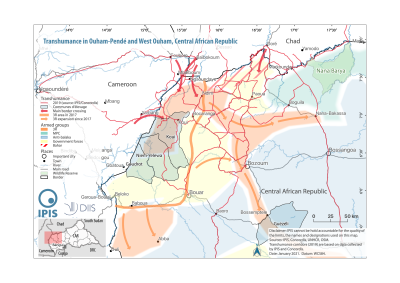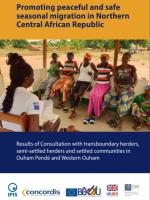Herding through insecurity
The borderlands of the Central African Republic (CAR) are home to one of the largest seasonal livestock migrations (transhumance) in the world. Decades of unrest and crisis, however, have brutally disrupted most aspects of herding—the routes taken, the people involved, governance mechanisms, as well as relations to local populations.
To understanding these changes and inform future peacebuilding efforts, DIIS researcher Peer Schouten collaborated with the Belgian conflict research organization IPIS and the British peacebuilding NGO Concordis in a large-scale participatory conflict mapping in CAR's western borderlands of Ouham-Pendé and Western Ouham.
The report takes a deep dive into the different mutual perceptions of transboundary and local herders, and sedentary people about the deep causes of conflict and pathways to peaceful cohabitation. It identifies changes in herding routes and practices, highlights barriers to peace, as well as opportunities for conflict transformation and economic growth.
The research found that herders and farmers seek recourse to armed groups and are caught in a complex web of self-defence and armed group predation. Herding and farming in the Central African drylands are production systems that rely on extensive and shifting land use patterns: farmers shift between fields, letting land lie fallow after a number of harvests, and herders similarly move their herds around to graze certain kinds of vegetation. Farming and herding can complement each other, producing complementary nutrients and services that can be exchanged to mutual benefit.
Both herders and sedentary people acknowledge that the militarization of rural CAR has disrupted this cohabitation. Sedentary people acknowledge that their youth are to blame — mobilising in so-called Anti-balaka groups, they raid cattle, provoking retaliation by herders. In turn, some herders acknowledge that youthful transboundary herders, traveling without family but with weapons, provoke animosity by disrespecting farmland and appealing to armed groups for conflict resolution.
Armed groups such as 3R have taken control of the governance of transhumance, by destroying local negotiations and institutions around access to seasonal pasture and replacing them with monetized pasture licenses for transboundary herders from Chad and Cameroon.

In exchange, armed groups levy heavy taxes in kind, appropriating vast numbers of cattle. Transboundary herders nonetheless prefer exposing their herds to insecurity in CAR, because its pastures are so rich--they'd lose more cattle to drought and limitations on herding in Chad or Cameroon. As one Chadian herder put it, ‘you can negotiate with an armed group, not with the drought’.
'These findings tell us two things', says Schouten. 'First, herders and farmers can and want to cohabit peacefully in the Central African Republic. Yet, second, armed groups have violently restructured pastoral systems, and it's an open question whether it'll be possible to restore peaceful transhumance as long as armed groups broker pastoralist mobility.'
DIIS Experts


